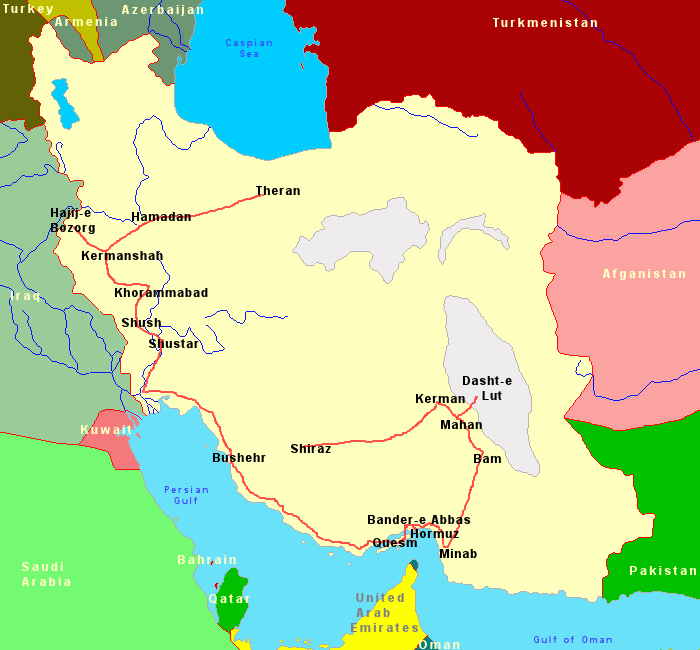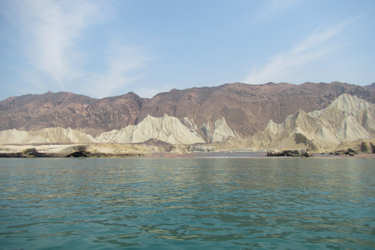Iran

Historie
The earliest archaeological artifacts in Iran, like those excavated at the Kashafrud and Ganj Par sites, attest to a
human presence in Iran since the Lower Paleolithic era, c. 800.000–200.000 BC.
Iran's Neanderthal artifacts from the Middle Paleolithic period, c. 200.000–40.000 BC, have been found mainly in the Zagros region.
The emergence of Susa as a city, as determined by radiocarbon dating, dates back to early 4.395 BC.
During the Bronze Age, Iran was home to several civilizations including Elam, Jiroft, and Zayande River. Elam, the most
prominent of these civilizations, developed in the southwest of Iran, alongside those in Mesopotamia. The emergence of writing in Elam was
paralleled to Sumer, and the Elamite cuneiform was developed since the 3rd millennium BC.
Between 3400 BC until about 2000 BC, northwestern Iran was part of the Kura-Araxes culture that stretched into the neighbouring regions
of the Caucasus and Anatolia.
Since the earliest 2nd millennium BC, Assyrians settled in swaths of western Iran, and incorporated the region into their territories.
During the 2nd millennium BC, Proto-Iranian tribes arrived in Iran from the Eurasian steppes, rivaling the native settlers of the country. As
these tribes dispersed into the wider area of Greater Iran and beyond, the boundaries of modern Iran were dominated by the Persian,
Median and Parthian tribes.
From the late 10th to late 7th centuries BC, the Iranian peoples, together with the pre-Iranian kingdoms, fell under the domination of the
Assyrian Empire, based in northern Mesopotamia.
Under king Cyaxares, the Medes and Persians entered into an alliance with Nabopolassar of Babylon, as well as
the Scythians and the Cimmerians, and together they attacked the Assyrian Empire.
The unification of the Median tribes
under a single ruler in 728 BC led to the foundation of the Median Empire which, by 612 BC, controlled the whole Iran and the
eastern Anatolia.
In 550 BC, Cyrus the Great took over the Median Empire, and founded the Achaemenid Empire by unifying other city states.
At its greatest extent, the Achaemenid Empire included the modern territories of Iran, Azerbaijan, Armenia, Georgia, Turkey, much of the
Black Sea coastal regions, northeastern Greece and southern Bulgaria (Thrace), northern Greece and Macedonia (Paeonia and Ancient Macedon),
Iraq, Syria, Lebanon, Jordan, Israel, Palestine, all significant ancient population centers of ancient Egypt as far west as Libya, Kuwait,
northern Saudi Arabia, parts of the UAE and Oman, Pakistan, Afghanistan, and much of Central Asia, making it the first world government and
the largest empire the world had yet seen.
In 334 BC, Alexander the Great invaded the Achaemenid Empire, defeating the last Achaemenid emperor, Darius III, at the
Battle of Issus. Following the premature death of Alexander, Iran came under the control of the Hellenistic Seleucid Empire.
In the middle of the 2nd century BC, the Parthian Empire rose to become the main power in Iran, and the century-long geopolitical
arch-rivalry between Romans and Parthians began, culminating in the Roman–Parthian Wars.
The Parthian Empire continued as a feudal monarchy for nearly five centuries, until 224 AD, when it was succeeded by the Sassanid
Ardashir I. The Sassanids established an empire within the frontiers achieved by the Achaemenids, with their capital at Ctesiphon.
The Sassanid Empire (224 to 651 AD) is considered as one of the most influential periods of Iran, as Iran influenced the culture of
ancient Rome (and through that as far as Western Europe), Africa, China, and India, and played a prominent role in the formation of both
European and Asian medieval art.
The prolonged Byzantine-Sassanid Wars, most importantly the climactic Byzantine-Sassanid War of 602-628, as well as the social conflict
within the Sassanid Empire, opened the way for an Arab invasion to Iran in the 7th century.
Initially defeated by the Arab Rashidun Caliphate, Iran came under the rule of the Arab caliphates of Umayyad and Abbasid.
After two centuries of the Arab rule, semi-independent and independent Iranian kingdoms such as the Tahirids, Saffarids,
Samanids, and Buyids began to appear on the fringes of the declining Abbasid Caliphate.
By the Samanid era in the 9th and 10th centuries, the efforts of Iranians to regain their independence had been well solidified.
The 10th century saw a mass migration of Turkic tribes from Central Asia into the Iranian plateau. Turkic tribesmen were first used in
the Abbasid army as Mamluks (slave-warriors), replacing Iranian and Arab elements within the army.
As a result, the mamluks gained a significant political power. In 999, large portions of Iran came briefly under the rule of the
Ghaznavids, whose rulers were of mamluk Turk origin, and longer subsequently under the Turkish Seljuk and Khwarezmian empires.
These Turks had been Persianized and had adopted Persian models of administration and rulership. The Seljuks subsequently gave rise to
the Sultanate of Rum in Anatolia, while taking their thoroughly Persianized identity with them. The result of the adoption and patronage
of Persian culture by Turkish rulers was the development of a distinct Turko-Persian tradition.
In 1219–21 the Khwarezmian Empire suffered a devastating invasion by the Mongol army of Genghis Khan. Following the fracture of
the Mongol Empire in 1256, Hulagu Khan, grandson of Genghis Khan, established the Ilkhanate in Iran. In 1370, yet another conqueror,
Timur, followed the example of Hulagu, establishing the Timurid Empire which lasted for another 156 years.
The Ilkhans and the Timurids soon came to adopt the ways and customs of the Iranians, choosing to surround themselves with a culture that was
distinctively Iranian.
By the 1500s, Ismail I established the Safavid dynasty, with Tabriz as the capital. Beginning with Azerbaijan, he subsequently
extended his authority, and established an intermittent Iranian hegemony over the vast relative regions, reasserting the Iranian identity
within large parts of the Greater Iran. Iran was predominantly Sunni, but Ismail instigated a forced conversion to the Shia branch of Islam,
by which the Shia Islam spread throughout the Safavid territories in the Caucasus, Iran, Anatolia, and Mesopotamia. As a result,
thereof, the modern-day Iran is the only official Shia nation of the world, with it holding an absolute majority in Iran and the Republic
of Azerbaijan, having there the 1st and 2nd highest number of Shia inhabitants by population percentage in the world.
The centuries-long geopolitical and ideological rivalry between Safavid Iran and the neighboring Ottoman Empire, led to numerous
Ottoman–Persian Wars. The Safavid Era peaked in the reign of Abbas the Great, 1587–1629, surpassing their Ottoman archrivals
in strength, and making the empire a leading hub in Western Eurasia for the sciences and arts.
Following a gradual decline in the late 1600s and early 1700s, which was caused by the internal conflicts, the continuous wars with the Ottomans,
and the foreign interference (most notably the Russian interference), the Safavid rule was ended by the Pashtun rebels in 1722.
In 1729, Nader Shah, a chieftain and military genius from Khorasan, successfully drove out and conquered the Pashtun invaders. He
subsequently took back the annexed Caucasian territories which were divided among the Ottoman and Russian authorities by the ongoing chaos
in Iran. During the reign of Nader Shah, Iran reached its greatest extent since the Sassanid Empire, reestablishing the Iranian hegemony all
over the Caucasus, as well as other major parts of the west and central Asia, and briefly possessing what was arguably the most powerful
empire at the time.
Nader Shah invaded India and sacked far off Delhi by the late 1730s. His territorial expansion, as well as his military successes, went
into a decline following the final campaigns in the Northern Caucasus.
The assassination of Nader Shah sparked a brief period of civil war and turmoil, after which Karim Khan of the Zand dynasty
came to power in 1750, bringing a period of relative peace and prosperity.
The Pahlavi dynasty was the ruling house of Imperial State of Iran from 1925 until 1979. The dynasty was founded by Reza Shah
Pahlavi in 1925, a former Brigadier-General of the Persian Cossack Brigade, whose reign lasted until 1941 when he was forced to abdicate
by the Allies after the Anglo-Soviet invasion.
He was succeeded by his son, Mohammad Reza Shah Pahlavi, the last Shah of Iran. Mohammad Reza introduced the White Revolution,
a series of economic, social and political reforms with the proclaimed intention of transforming Iran into a global power and modernising
the nation by nationalising certain industries and granting women suffrage.
Ruhollah Khomeini, a radical Muslim cleric, became an active critic of the Shah's far-reaching series of reforms. Khomeini publicly
denounced the government, and was arrested and imprisoned for 18 months. After his release in 1964, he refused to apologize, and was
eventually sent into exile.
The 1979 Revolution, later known as the Islamic Revolution, began in January 1978 with the first major demonstrations against the Shah.
After a year of strikes and demonstrations paralyzing the country and its economy, Mohammad Reza Pahlavi fled the country and Ruhollah Khomeini
returned from exile to Tehran in February 1979, forming a new government. After holding a referendum, Iran officially became an Islamic
Republic in April 1979. A second referendum in December 1979 approved a theocratic constitution.
On 22 September 1980, the Iraqi army invaded the western Iranian province of Khuzestan, launching the Iran–Iraq War. Although the forces
of Saddam Hussein made several early advances, by mid 1982, the Iranian forces successfully managed to drive the Iraqi army back into Iraq.
In July 1982, with Iraq thrown on the defensive, Iran took the decision to invade Iraq and conducted countless offensives in a bid to conquer
Iraqi territory and capture cities, such as Basra. The war continued until 1988, when the Iraqi army defeated the Iranian forces inside Iraq
and pushed the remaining Iranian troops back across the border.
Hassan Rouhani was elected as President of Iran on 15 June 2013, defeating Mohammad Bagher Ghalibaf and four other candidates. The
electoral victory of Rouhani has improved the relations of Iran with other countries.
I have visited Iran in april 2017
These are the places where i hve seen
Theran
Hamadan
Kermanshah
Hajij-e Bozorg
Khorammabad
Shush
Shustar
Bushehr
Quesm Island
Bandar-e Abbas
Hormuz Island
Minab
Bam
Mahan
Dasht-e Lut
Kerman
Shiraz
Please let me know when you're having questions.
i would be pleased to help you.
Things to do and other tips
